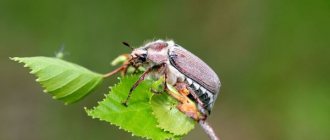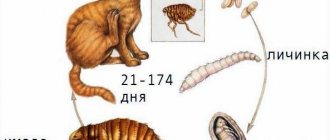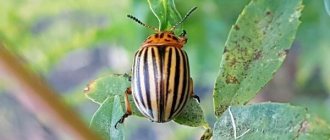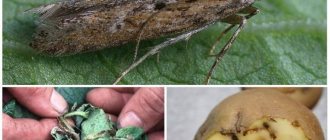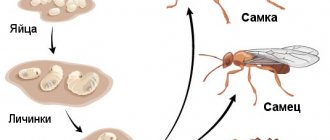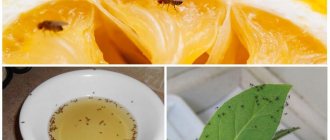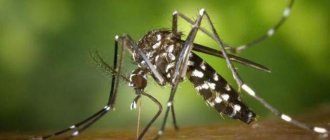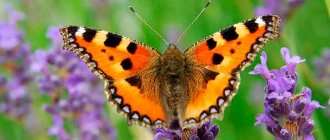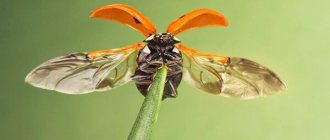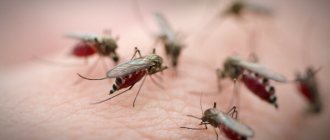Features and habitat
Wasp - belongs to the order Hymenoptera, and the suborder Stalk-bellied.
Wasps include insects such as:
- real;
- sand;
- wasps - shiners;
- road;
- scolias;
- wasps are German;
- Typhia;
- floral;
- burrowing;
- paper;
- hornet.
The wasp is an insect whose body is colored with stripes of black and yellow. The length of the insect (depending on the species) ranges from 2 cm to 3.5 cm. There are two pairs of wings on the back, but since the hind wings are tightly linked to the front wings, it seems that there are only two wings.
Wasp stings are painful, accompanied by swelling, and can cause a serious allergic reaction. At the same time, unlike bees, wasps do not leave a sting.
The eyes of this insect consist of many facets that allow you to look in different directions at the same time, and protrude down beyond the plane of the stigma.
In addition to the complex, compound eyes, the wasp has three more eyes, which are located at the very top of the head. It’s hard to believe that such a small insect is so big-eyed, but if you look at the wasp in the photo , you can easily see this.
The photo shows three additional wasp eyes.
In addition to huge eyes, there are also antennae on the head. These antennae are multifunctional. They are also organs of smell and touch, they also perceive air vibrations, they also act as taste buds and, moreover, when building a nest, each cell is measured with antennae.
Interesting! Only female wasps have a sting. This is explained by the fact that this organ is an ovipositor and only when there is danger, the wasp injects poison through it.
The types of insect wasps are quite diverse and there are many of them, but they are all divided into social and solitary. Already from the name it is clear that solitary wasps prefer to live separately, without large companies.
They don't even build nests. But every single wasp has the opportunity to continue its genus, that is, to reproduce. But social wasps cannot live alone; they live in families, the number of which can number several thousand wasps.
Such wasps build themselves a serious home - a strong and reliable nest. Unlike solitary wasps, social wasps cannot all reproduce. Only the queen and males can participate in reproduction; the rest of the wasps are sterile.
In social wasps, nest construction begins with the queen. She can build a small dwelling, no larger than a walnut. She essentially needs a small nest where she can lay her first eggs.
First, the housing is all in one layer. But later the uterus builds up other tiers. It will work until young, working wasps hatch from the eggs.
And now they continue construction, freeing the queen for the most important task - increasing the aspen population. By the size of the nest, you can determine how rich the family is in workers.
Single wasps are not too sophisticated about building a nest, and if they do build one, then they have quite a lot of different methods of construction. Some build small cells in places protected from the weather and from prying eyes, and, for example, pottery wasps build something like a vase out of mud, which is attached to a wall or to tree branches.
There are wasps that simply burrow into the ground or bite through the stems of plants in order to find shelter there, and there are also those that prefer to find small crevices suitable for them to live. For such individuals, everything that remains from a person is also suitable - abandoned work gloves, pieces of three-layer cardboard, unnecessary things, etc.
Interesting! Solitary wasps lay their eggs exclusively in a single cell and then seal it. In this case, there is no interaction between adult wasps and larvae.
It was also noticed that eggs are laid in smaller cells, from which male larvae later hatch. This means that they have fewer males than females.
The photo shows a clutch of wasp larvae
A variety of wasps live wherever possible. However, most of all they like to settle next to a person. This is understandable; humans are a constant dining room for these insects, where they do not need to make any special efforts to obtain food.
Anatomy of a wasp
Wasps belong to the Hymenoptera, which are the most numerous group of insects, including about 155 thousand species. A peculiarity of the body structure of these insects is that between the abdomen and the breast there is a thin membrane in the form of a stalk, which contributed to the emergence of such a thing as a “wasp waist”. The body of an insect consists of 3 parts - head, chest and abdomen. Despite the fact that all species differ in body color, colors such as black, yellow and orange are always present.
The structural feature of the wings can also be attributed to the distinctive feature of these insects. As a rule, the wings are quite thin and transparent, with clearly visible veins. The hind wings are somewhat shorter than the fore wings. They can shimmer in different colors, but can also be completely colorless. Each wasp leg consists of 5 segments. They perform various functions, including digging.
On the insect's head you can see whiskers of various shapes and lengths. The whiskers also perform various functions, including allowing the insect to navigate in space. The eyes are clearly expressed. Although the jaws do not have teeth, they are powerful enough to bite through the chitinous layer of the insect.
The wasp, like the bee, has a sting, which is located on the underside of the abdomen. As a rule, only females can sting. The sting is quite thin and is connected to a gland that produces poison of varying toxicity. With the help of poison, the wasp protects itself, its young, its nest, and so on.
In the photographs below you can take a closer look at what wasps look like. Wasp larvae are very different in appearance from adult individuals, since they are not pure white caterpillars. These are predatory caterpillars that feed on protein foods.
Character and lifestyle
The character of striped predators is quite bad, that is, frankly aggressive. At the slightest disturbance, this insect attacks first. The wasp not only stings, but also bites the enemy, although bites with the mouth are much less noticeable than working with a stinger.
If there is another wasp nearby, sensing the smell of poison, it will rush to help the attacking wasp. And woe betide the one who disturbs the hornet’s nest. Then a whole cloud of wasps will fly out to protect their home and the culprit will be very unlucky.
At the same time, wasps are very caring nannies and mothers, although this applies mainly only to social wasps; in solitary wasps, the mother’s care is expressed only in providing the larva with paralyzed prey - they provide their larvae with food for a long time during their development. In social wasps, caring for their offspring is much more difficult.
Each wasp in the family goes through all the “working” stages. If at first a young individual can only be a cleaner, then with age she is “promoted” to the rank of wet nurse.
Wasps find their nest unerringly, even when they fly many kilometers away from it. But if the nest is moved even a few meters, finding its home will be a very difficult task for this insect.
Nutrition
Wasps are predatory insects, although they are known to have a “sweet tooth.” You should not leave bowls of jam on the summer veranda after drinking tea; wasps will certainly discover this gift and fly here for a new portion. Wasps can lick nectar from flowers, or they can also snack on smaller insects.
And yet, one has only to remember the wasp-rider, and doubts about predation will disappear. This wasp looks for a well-fed caterpillar, sits astride it (like an equestrian), pierces the skin with its ovipositor and lays eggs in the body of the victim.
Later, the larvae will be provided with food, that is, this very caterpillar. Some wasps choose beetles instead of caterpillars. The Pepsis wasp (road wasp) even tracks spiders, attacking them, sometimes even in their own home, and lays its eggs in the body of this spider.
Reproduction and lifespan
After a warm winter (a secluded place is specially located for this), the queen begins to build a nest and lay eggs there. From these eggs only sterile individuals will emerge, which will further build the nest and obtain food.
And only towards the end of summer the queen begins to lay eggs, from which wasps will emerge capable of reproducing. It is these individuals that swarm and mate with each other.
After fertilization has occurred, young females fly out of the nest and look for a warm shelter for the winter, so that in the spring they can build their own nest. The males die. With the onset of cold weather, the entire abandoned wasp family, along with the old female, dies.
One female mates once and is capable of producing more than 2000 wasps. For the most part, these are worker wasps, sterile. The eggs are sealed in a chamber along with small insects (food). The larvae will then feed and gain weight in order to turn into a wasp.
The larvae that will produce wasps capable of reproducing feed differently. They are fed food that promotes the formation of reproductive organs. After the wasp emerges from the larva, it climbs out of the chamber on its own. The queen is 10 months long, but worker wasps and drones are only 4 weeks old.
Winter hut of wasps
Where wasps spend the winter is a common question. After all, most people know very little about wasps, but are terribly afraid of them. This is due to the fact that the insect can sting a person very painfully. The stings of paper wasps, which we so often see in parks, gardens or markets, are very painful and cause serious allergic reactions.
Experts say that wasps are very interesting and even unique insects in many ways, and they only attack when disturbed. In this publication we will also describe in detail the lifestyle of wasps and what this insect eats.
Enemies
Wasps are killed ahead of time by insecticides used by humans to combat various agricultural and forest pests, directly against wasp families. Among the main enemies of common wasps are hornets, as well as some species of birds. In autumn, inactive insects are eaten by animals, spiders, and large beetles.
The lifespan of the wasp family also depends on weather conditions. Nests and hives are destroyed by floods, forest fires, and premature frosts. A wasp can live genetically for a long time, but in practice the lifespan is shortened several times.
It is known that there are varieties of wasps, the differences in their lifestyle, appearance and even behavior. In general, they can be divided into 2 parts: social and solitary insects. Today it is difficult to imagine a warm period of time without them, especially since they often interfere and can even sting people. All this makes such a neighborhood not always necessary.
Variety of species
The wasps that are familiar to most of us and have yellow and black stripes on their bodies are called paper wasps. This species name is due to the fact that the material from which insects build their homes is very similar to paper. It is made from wood fibers chewed by arthropods, which are glued together with saliva.
Other types of wasps have different colors. The size of the insect depends on its species. They range from 1.5 cm to 10 cm. What do wasps eat? The adult eats mainly liquid food - nectar, fruit juice. For their larvae, wasps get: flies and other insects. Predatory wasps themselves eat insects, and can also feed on other types of food.
The wasp catches its prey and injects its poison into it through its sting, which does not kill, but only paralyzes. Thus, the meat of the prey is kept fresh until the time of the meal.
Different types of wasps live almost everywhere. For example, ground wasps choose soil to build their “homes”. Paper wasps build their “family nest” under a tree branch or on any structure. It should be noted that wasps are very willing to settle near people. This proximity makes it much easier for them to find food.
The wasp eats sweets and other foods left in a visible place in a person’s home. But also, it catches pests there such as flies, which carry various infections and thereby brings benefits. In the garden, wasps can find not only flies and ants, but also a huge number of insects that are pests. Wasps love honey very much and therefore pose a threat to bees.
The queen is the largest individual of the paper wasp family. The length of its body is approximately 20 millimeters, while the body length of a working wasp or drone is about 18 millimeters. Females have a larger abdomen than males. Insects do not differ in body color by gender. Males and females have the same yellow and black striped color.
Features of some types
Varieties of paper specimens are black and yellow in color. The nests are round and can be found in the attics of buildings and the walls of various buildings. Nests are made from paper produced by the individuals themselves.
The flower wasp is a very small creature, its size reaches no more than 1 cm. They feed on pollen and nectar of various flowers. The flower wasp builds a nest from sand and clay, holding them together with its saliva.
The largest representative of the family is the hornet. Its length can reach 55 mm. Parasitic wasps include glitterweeds. These bright and shiny individuals are accustomed to living on other bees and butterflies. Sand wasps dig holes in the ground to live in. Road views do the same. The food for the larvae is spiders and insects, paralyzed by the poison from the sting of adults.
This insect belongs to the order Hymenoptera
Scolias look very beautiful. These are insects up to 10 cm long. They look more like butterflies.
Black wasp Typhia. They often settle on the body of the cockchafer. Sometimes they burrow into the ground in search of beetle larvae.
All the nuances of appearance
The wasp belongs to the order of Hymenoptera insects, the suborder of stalked bellies.
The description of the structure of the insect allows it to be classified:
- The body consists of three clearly distinguishable segments - the head, thorax and abdomen, which are supported by a strong external chitinous skeleton.
- Between the chest and abdomen the insect has a long thin stalk, reminiscent of a narrow “waist”. It is this feature of the waist that defines the suborder. This structure allows the wasps to almost fold their body in half, and also sting the “enemy” from any angle. That is why, in fights with a larger opponent, these insects emerge victorious.
- The abdomen of the arthropod is covered with villi and has the shape of either a spindle or a barrel.
The question: how many eyes does a wasp have is not trivially simple. The striped insect, unlike the fly, is very “big-eyed” - the total number is five. On the sides of the head there are two large eyes of the wasp, protruding down beyond the plane of the stigma.
They have a very complex structure - they consist of a huge number of facets. As a result, the arthropod can look in different directions at the same time. At the very top of the head there are three more eyes. The upper part of the head is also decorated with a pair of antennae.
This organ is very multifunctional:
- perceives air vibrations;
- responsible for the sense of smell;
- is an organ of touch;
- has taste buds.
In addition, the wasp uses antennas as a measuring tool. When building a nest, she measures each cell with them. On the back of the wasp there are two pairs of membranous wings, which are fastened together. Therefore, visually, it seems that the insect has only one pair of wings. True, some types of wasps do not have wings at all.
Aggressive insect
The peculiarity of the structure of the ridge allows the head to move very well. The mouthparts of an insect are of the gnawing type. It is designed to grind food and wood fibers used in the construction of honeycombs. Stripes have a serrated sting, which does not have a knot at the end, but the serrations are smaller than those of a bee.
Only females have a sting. After all, in essence, it is an ovipositor, through which, if danger arises, the “minke whale” can also spray poison. But wasps are quite aggressive and prefer to attack first. Females quite often use the sting for purposes other than its intended purpose.
Nature dictates that the bright yellow-black color makes the insect very noticeable and thereby warns other animals that its owner is poisonous. The minke whale stings and bites its opponent. Although the bites are less painful than the venom released by the stinger.
It should be borne in mind that minke whales attack at the slightest disturbance - this demonstrates how dangerous they are to their enemies. When biting, it does not leave a sting in the body of its “victim”, as bees do. Therefore, insects do not die after being stung. They may repeat the attack again.
It is very important to know that the venom of the striped insect has a smell. If one wasp stung and another was nearby, it will smell the poison and fly to the aid of its “relative.”
It is especially dangerous to disturb a formidable arthropod near its home. Then the whole family can attack. It’s not for nothing that there is a saying “to stir up a hornet’s nest,” which implies major troubles.
What happens if you open a wasp's nest (video)
Wasps are unique insects. They belong to the order Hymenoptera. This order also includes bees, bumblebees, ants, sawflies and riders. Ants and bees are descendants of ancient wasps. Over the centuries, flower nectar became their food, and the ants lost their wings. Therefore, a wasp on a flower is a fairly common occurrence. These insects live both alone and in families. This is an insect that is studied by many specialists. They divide these flying creatures into several groups. The flower wasp stands out from them. This is an insect that lives alone. Quite a few individuals belong to the social group. First of all, this is a village wasp. Together with it we can name representatives of paper Hymenoptera. They are the ones most often encountered by summer residents in Russia.
The common wasp is not the only species on our planet. There are and have been many other types of these creatures. These include species that lived long before modern representatives. These are ants and a sand individual. The structure of the wasp is almost the same in all species: abdomen, chest and head with antennae, decorated with huge eyes. Russian wasps of many species are found throughout the country. This is a predator wasp that feeds on living things, the wasp fly.
Wasps live as long as conditions allow. The female that lays eggs can live 3-4 years, working insects - about 2 months. They are the ones who care for the larvae and obtain food for the family. These individuals are a kind of operational workers in the family. In general, they bring great benefits to humans, destroying many harmful insects in the garden.
Main distinguishing feature
The life of a wasp depends on whether it is a social or solitary individual. Already from the name it becomes clear that the former live in families, and the latter – separately. This division exists in all numerous insect species. Each single individual has the opportunity to reproduce. In the family, only the uterus continues the family line.
Solitary wasps prefer not to live in large groups. They mate and then lead a solitary life. Paper single females build their nest. In each cell, in addition to the laid egg, the female places a supply of food for the impoverished larva. These are small insects and spiders paralyzed by poison. Having filled the cell, the female seals it.
The larva eats the supplies prepared by the caring mother and develops inside the cell. When it reaches maturity, it gets out of the nest on its own. Young insects fly away in search of a place to build their own “home”.
Spring troubles of public wasps
The female of a social species is fertilized by the male only once.
Having overwintered, she begins to look for a suitable place for a “family nest.” This could be a tree branch or the ceiling of a building. In the spring, she must build several cells that will be connected to each other - this is how they get honeycombs. She lays one egg in each cell. The eggs develop very quickly - in about a week. The queen feeds the larvae that emerged from the eggs with chewed insects. The larvae, covered in cobwebs, turn into pupae. A few days later, worker wasps emerge from the pupae - these are sterile females. Already in July they take upon themselves the responsibility of completing the “house” and taking care of the mother and the larvae.
From this time on, the uterus is engaged only in laying eggs. After all, she needs to put aside about 300 pieces a day. In addition, she carefully monitors the order in the house. It often stings workers who do not perform their duties well. All workers are sisters to each other, and the female team needs an eye and an eye.
Summer-autumn period
Experts say that it is the food that the larva eats that determines who will emerge from it - a working disembodied individual, either a female or a male.
The queen lays eggs only at the end of summer, from which insects capable of reproduction will hatch. They are fed food that promotes the development of reproductive organs. What does it consist of? This can be chewed pieces of leaves and other plant foods, as well as “meat” in the form of various insects. In particular, flies, beetles, spiders, etc. The wasp larva does not leave the cell until it becomes an adult. Having reached maturity, the insects swarm and mate with each other. Thus, the life cycle begins anew.
Hibernation
Not all wasps hibernate in winter, only young, fertilized females do.
Males die after fertilization. With the onset of cold weather, the wasp family dies, which has already been abandoned by young female and male individuals. Essentially, the old queen and the worker wasps that lived in the nest die. After all, the lifespan of working individuals is only 4 weeks. Then, as a queen wasp, the wasp lives for 10 months. Young females, having left their father's house, are looking for a place where they can spend the winter comfortably. After they find a warm, secluded place, they fall asleep. In order for insects to wake up, the onset of spring warmth is necessary.
Arthropods wake up when the air temperature exceeds +15 C. Therefore, minke whales can wake up prematurely during winter thaws. When new cold weather sets in, they will die.
We considered only the most interesting facts from the life of wasps.
These insects certainly bring many benefits to people - they destroy flies and garden pests. But they are the worst enemies of bees and are a threat to apiaries. In addition, a wasp sting causes a severe allergic reaction and sometimes death.
How long do wasps live?
Wasps are annoying, brightly colored insects. How long different representatives of wasps live depends on the species and the insect’s place in the family hierarchy.
Lifespan
Various representatives of the wasp family can live from a couple of months to several years. Species and external natural factors influence how long wasps live. Wasps are conventionally divided into solitary and social; their life spans are different.
Social ones live in a strict hierarchical system, like bees. Singles lead an isolated existence.
Uterus
The long-lived female among social wasps of all species lives for several years. All summer, the queen actively replenishes the population of the nest, continuously laying eggs. Towards the end of August, new, large cells for special offspring appear in the nest. From these cells young females and males hatch.
Before the onset of cold weather, they mate, after which the males die, and the future mothers of the family look for a place to winter. Females hide under bark, remnants of grass, and leaves. How many years the queen will live depends on a well-chosen location. Smart and lucky ones will survive 3-4 winters.
Working individual
Workers are the main population of a wasp hive, females who are not capable of reproduction. The working individual lives for about two months, the composition is constantly updated due to the continuous work of the uterus. By the end of summer, construction is no longer required; the worker wasps have completed their function. They restore order in their summer residence by eating larvae that have not yet been born.
After the act of cannibalism they set off on a journey. With the onset of the first frost, everyone dies. There are theoretical data according to which the queen of some species of the wasp family leaves the nest, dying along with the workers.
Males
In the tough wasp matriarchy, males are not particularly favored. They are born to fertilize females at the very end of summer; with cold weather, certain death awaits them. The lifespan of a male is about a month, with a maximum of 40 days. It all depends on the time of frost.
Species dependent
Solitary species do not live more than six months. All summer the female is active. She lays eggs and obtains food for herself and the larvae. Some species of solitary road wasps lead a “thieving” lifestyle, stealing the prey of their sisters for their own offspring. When the cold comes, both females and males die. New wasps will emerge from their burrows only in the spring.
The lifespan of social species depends on gender and external factors. Life expectancy data by gender:
- working females live 2 months
- drones – 40 days
- uterus – 1-4 years
Enemies and danger to life
Wasps are equipped with a magnificent weapon - a poisonous sting, but they themselves become victims.
Other insects and larger enemies attack: birds and mammals.
- The most dangerous enemies of wasps are... the wasps themselves. More precisely, one of the wasp species is hornets. Hornets are the largest and most numerous, real killers, capable of completely encircling an entire settlement, destroying all their fellow creatures living in it.
- One of the natural enemies of wasps is also the paradoxical fan beetle. The larvae of this beetle attach to adult individuals and end up inside the wasp colony. In the hive, they penetrate the cells and feed on the larvae. Having emptied the cell, the fantail pupates right in the cradle of its victim. The adult that emerges from the cocoon leaves the nest.
- The wasp society may be weakened due to the premature death of the queen. Then the nest can be destroyed by ants. They will profit from the remaining larvae. They will not disdain weak or sick individuals.
- The closer the cold, the slower and weaker the insects. In early autumn and spring, they easily become prey for birds or bears.
- The most dangerous enemy of wasps is people. If a wasp house turns out to be close to any housing, then in the near future they will prefer to get rid of it, on their own or with the help of specialists.
Life after the bite
During one attack, the wasp can sting several times in a row, as long as the supply of poison allows. The wasp's sting has no jagged edges, thorns, or irregularities. It is removed from the victim's body without resistance, allowing the attack to continue. Having stung, the insect does not die unless a person or large animal crushes the wasp during the bite. An individual that dies during an attack leaves a stinger at the site of the bite; it must be removed.
Lifespan of wasps
How long wasps live usually depends on many factors, but most of all on their hierarchical arrangement in families. Working individuals, as a rule, die the fastest; the life cycle of the queen lasts longer.
The presence of alternating black and yellow stripes along the body is a distinctive feature of wasps. Insects also have membranous wings, antennae, which are also considered respiratory organs, and powerful jaws. Depending on the variety, the dimensions may vary, for example, for a burrowing wasp, a normal length is considered to be from 5 to 20 mm, for a scolius - from 10 to 100 mm.
Important! The presence of poison in these insects is indicated by their bright colors. The sting is an ovipositor with a modified appearance, considered characteristic only of females, they are the ones who are able to attack.
Wasps have never been long-lived. Their life depends on many factors related to the environment and the species. Social families of wasps live according to an internal hierarchy, which affects not only the distribution of responsibilities, but also the period of life. Each individual in the family performs its own functions and is distinguished by its significance. Within families, the following types are distinguished:
- queen - manages the colony and lays eggs to raise offspring;
- females that are unable to lay eggs are considered worker wasps;
- females that can conceive offspring at certain times of the season.
Polista, or paper wasps, are considered popular representatives of the subfamily. Spring is the time for the young queen to find a nest and begin building it. To build a place for offspring, chewed grass and tree bark are used. When summer comes, the first offspring of working insects are born, which resemble the queen, but are smaller in size. Such a brood can live up to two months. Towards mid-September, individuals appear in special cells whose reproduction is capable of producing young wasps.
Polista or paper wasp
When it gets cold and winter comes, the males begin to leave the nests and die. In general, they are able to live up to 3 months. Queens overwinter under the bark of trees, in crevices and grassy debris. Thus, the lifespan of a wasp can extend up to 4 years. In general, the wasp’s life period is associated with warmth, since only certain members of the family are able to survive the winter in frosty conditions.
What determines the lifespan of wasps?
Insects are not among the long-livers. The lifespan of a wasp depends on environmental factors and its species. Social insects living in families have an internal hierarchy, which implies not only the distribution of responsibilities, but also affects the duration of existence.
Social wasps
The insect colony is distinguished by a clear division of responsibilities and importance in the life of the family. Three types of adults coexist in the nest:
- the queen, which lays eggs and runs the colony;
- infertile females are working insects;
- males capable of fertilization in a certain season.
Polite or paper wasps are the most famous representatives of the subfamily. In the spring, young queens look for a place for a nest, which they begin to build on their own. To build a house, they use chewed grass and tree bark. At the beginning of summer, the first working individuals are born; they are similar to the queen, but are smaller in size - 18-20 mm versus 25 mm. The lifespan of a young wasp is about 2 months.
At the end of summer and in September, males and females grow up in special cells and are capable of giving birth to offspring. They fly out of the nest and mate. With the onset of cold weather, males fly away from home and die. They will live 2-3 months. Old poppies, along with young ones, mate for
Why are wasps needed in nature?
Wasps, unlike their striped relatives, have not received enough respect from people. This is largely due to the fact that few people know what wasps are needed for in nature, because they do not produce honey, sting and even cause allergic reactions. It is quite logical that the question arises what wasps do, and whether they have any benefit for people and the environment.
Benefits from insects
What benefits do wasps bring:
- They destroy small bugs. The adult feeds on nectars and fruit juices. The wasp larva must eat protein to develop. To feed their offspring, wasps need to hunt pests, these can be flies, mosquitoes, aphids, spiders and other pests living in the garden;
- Destroy the mole cricket. Insects are able to drive the pest out of the ground, then paralyze the victim by injecting poison. Now the paralyzed body of the mole cricket becomes a kind of incubator. All this time, the pest remains alive, does not allow the wasp larvae to die, constantly feeding them with the necessary components. The mole cricket meets death immediately after the last moult;
- They pollinate plants and flowers. For full development, many plants need to be pollinated, which wasps do very well;
- Used in medicine to fight cancer. Scientists have proven that Brazilian wasps have a poison with a unique composition that helps destroy cancer cells without damaging healthy areas;
- Protect weak insects. Knowing about the ability to bite, hunt and show aggression towards other insects, weak individuals took on the colorful color of predatory insects. This is due to a subconscious reluctance to encounter wasps. Stripes save the weak from birds, some types of flies, beetles, butterflies and many others.
Natural enemies of wasps
Nature is designed in such a way that every living creature on the planet has its own natural enemies. Wasps are no exception, despite the fact that they are armed with a poisonous sting. For example:
- The nests of wasps that are left without a queen are actively destroyed by ants, destroying weak or sick individuals.
- The wasps are preyed upon by the paradoxical fantail, which sneaks into the wasp nest and lays eggs. The larvae of this insect parasitize young wasps.
- Hornets are the most dangerous and formidable enemies of wasp families. In one attack, hornets are capable of destroying an entire family of wasps, since they have an advantage in size and also in numbers.
- Wasps are also hunted by honey-buzzard birds, which feed the chicks with larvae and adults.
With the arrival of autumn, when the air temperature drops noticeably, wasps become less active, so they become victims of some insects and birds.
It is difficult to meet a person who has not encountered wasps in his life: they are everywhere. They can be found both in small villages and in megacities. You can even say this: where there is a person, there are wasps, since next to a person this insect can always find food for itself.
How do they reproduce?
Towards the end of the warm period, workers add large honeycombs to the nests. All this is necessary for the queen to lay eggs. Then, within 20 days, females and males are born, which are called drones. By the end of August, the young offspring need to be well fed in order to get stronger. All this time they are protected by the roof of the nest. With the arrival of autumn, drones begin to mate. At one time, the male fertilizes the uterus with so much biomaterial that she can lay eggs throughout her life.
The predecessors of drones are not able to survive frosts, so they die. After the wasps reproduce, the young female is able to fall asleep, lay eggs again when spring arrives, and reproduce. Moreover, during all the warm months, only worker wasps are born. Fertile offspring appear only with the arrival of August. The timing of the mating season may also explain why wasps attack people for no reason and are especially active and aggressive towards other insects.
Wasp life cycle, lifestyle
Everyone has encountered wasps at least once and is well aware of their aggressive nature.
The insect, without hesitation, will attack first if it senses danger. Predators are capable of not only stinging, but also biting with their jaws, which in itself is less painful. The family also has a herd instinct. If there are wasps nearby that sense the poison, they will come to the rescue and help attack. The entire short life cycle of insects can be divided into several stages:
- Birth and arrangement of the nest. With the arrival of warmth, the queen begins to nest to give life to a new generation;
- Reproduction. After laying eggs, fertile males and females emerge, ensuring further reproduction.
Every gardener, knowing why wasps are needed, will say that wasps only get in the way, because they spoil the fruit harvest, attack people and animals, and feed on the leftover sweet foods from the table. But they also destroy other pests that attack garden plots
In addition, they pollinate plants, which is also important
There are a huge number of wasp species in the world, which differ in lifestyle, behavior and appearance. They can be divided into two groups, which determine the main characteristics - social and solitary wasps. These insects have become a familiar environment during the warm season. They can be annoying and often aggressive, which is why people find such a neighborhood unpleasant. How long wasps live depends on their position in the family hierarchy. Working individuals die quickly, but queens live longer.
What do they eat in summer
The diet and feeding habits of larvae and adults differ significantly. Thinking about what wasps eat, you might think that they are omnivores, but this is a mistaken opinion. There are quite a lot of things that wasps eat and will never touch. Moreover, they are quite picky when it comes to nutrition.
The most constant food for insects is fruit and berry juice, which ripens during the period of their activity. Such nutrition is the main source of energy. In addition, wasps love the insides of berries and are able to leave behind only the skin. This applies to plums, raspberries, strawberries, blackberries and grapes.
Representatives’ favorite products are also:
- Sugar;
- Honey products;
- Fruit varieties of jam;
- Sweet syrups.
In turn, the larvae feed exclusively on protein tissues, that is, on other insects. Suitable for feeding and development of future offspring:
- Slug;
- Butterfly;
- Spider;
- Caterpillar;
- Cockroach;
- Bedbugs and other insects.
Important! If there are hives with bee families nearby, there is a danger of the striped workers being destroyed by predators.
When wasps go to bed
Many people wonder when wasps go to bed, and whether they sleep at all. When touching on this issue, it should be taken into account that at a time when insects have nothing to eat, they hibernate. At the same time, their metabolism freezes, and the body does not feel temperature changes.
Important! The body of the uterus provides it with a substance whose properties resemble antifreeze, which prevents it from freezing even in severe frosts. In such cases, a smooth change in temperature is necessary for survival to avoid death due to awakening too early.
Also, wasps always care about where they will spend the night. These can be tall plants and grasses, to which they are attached individually with their jaws and paws. Rarely, but there are cases when insects spend the night in a group.
Wasps attack people for no reason
Wasps are considered one of the most dangerous insects, stinging their prey. Like all things stinging, the wasp is considered a predator whose bite brings a lot of pain. After a bite, a person feels severe pain, after which other unpleasant symptoms may appear.
The first reason why wasps attack is an attempt at defense. Like any predator, the wasp is evil by nature, so any confrontation with it is perceived as an attack. Usually such fights only end in bites.
The distinguishing signs of a wasp sting are:
- Instant redness and swelling of the bite site;
- The pain is accompanied by severe itching;
- The appearance of an allergic reaction;
- The whole body begins to itch, a rash appears;
- In the place where the sting occurs, acute pain appears;
- Anaphylactic shock.
Additionally, the following may appear:
- severe dizziness;
- vomiting, nausea;
- acceleration or deceleration of heart rate;
- increase in temperature.
Note! The most dangerous symptom is considered to be anaphylactic shock, which most often affects allergy sufferers. Moreover, if qualified medical care is not provided within a short time, a person may die from a wasp sting.
Do wasps die after being stung?
Many people believe that a wasp and a bee are insects that have no differences. But this is completely wrong. Not only do they live different lives, but they also attack differently. Here the question arises: who dies after a sting: a bee or a wasp.
The main weapon of wasps is the sting, which is a modified oviposition. During quiet times it is hidden inside. As soon as the insect senses danger, the muscles push it out.
When attacking their prey, wasps pierce the skin with their sting and inject poison. Does a wasp die after being stung? No. Unlike a bee, a wasp can sting more than once. Moreover, after the attack, they calmly continue their life activities. When a predator senses danger, it attacks the prey, then pulls out its sting and flies away. This is due to the smoothness of the sting itself.
Types of wasps
These insects were divided into 2 large groups, according to the main classification.
Social wasps
Such insects are often called by different names, including paper insects. Social wasps live in colonies, which can number up to a million individuals. At the same time, they can build nests of various sizes, from the diameter of an apple to 60 cm in size. You can see this in the photographs.
In a large family, individuals are divided into castes, and they communicate using sounds and signals. The family is headed by the queen, who is engaged in reproducing offspring. There are species of wasps in the nest of which there may be several female queens who do not have the status of queen of the family, but are engaged in increasing the number of the aspen family.
Solitary wasps
This class of wasps is distinguished by the fact that each individual lives separately, so they do not build nests. As a rule, these are predatory insects. They lay their future offspring on the bodies of the larvae of various large insects. In this case, the larva develops independently, feeding on the flesh of the larvae. After destroying its victim, the larva pupates and waits for the arrival of spring. After wintering, with the arrival of real warmth, an adult wasp emerges from the pupa. Single wasps are quite poisonous, and their bite has been compared to piercing human skin with hot metal. Photos and names of wasps can be seen below in the text.
Interesting to know! Social wasps have several other names: wood wasps, paper wasps, etc. Solitary wasps are divided into species, which are named - sand, road, burrowing. Among all this diversity, there are species that are absolutely safe and useful, and there are parasitic wasps and killer wasps.
In our country, wasps can be found almost everywhere, and their variety is huge.
Read also Armagold instructions for use
